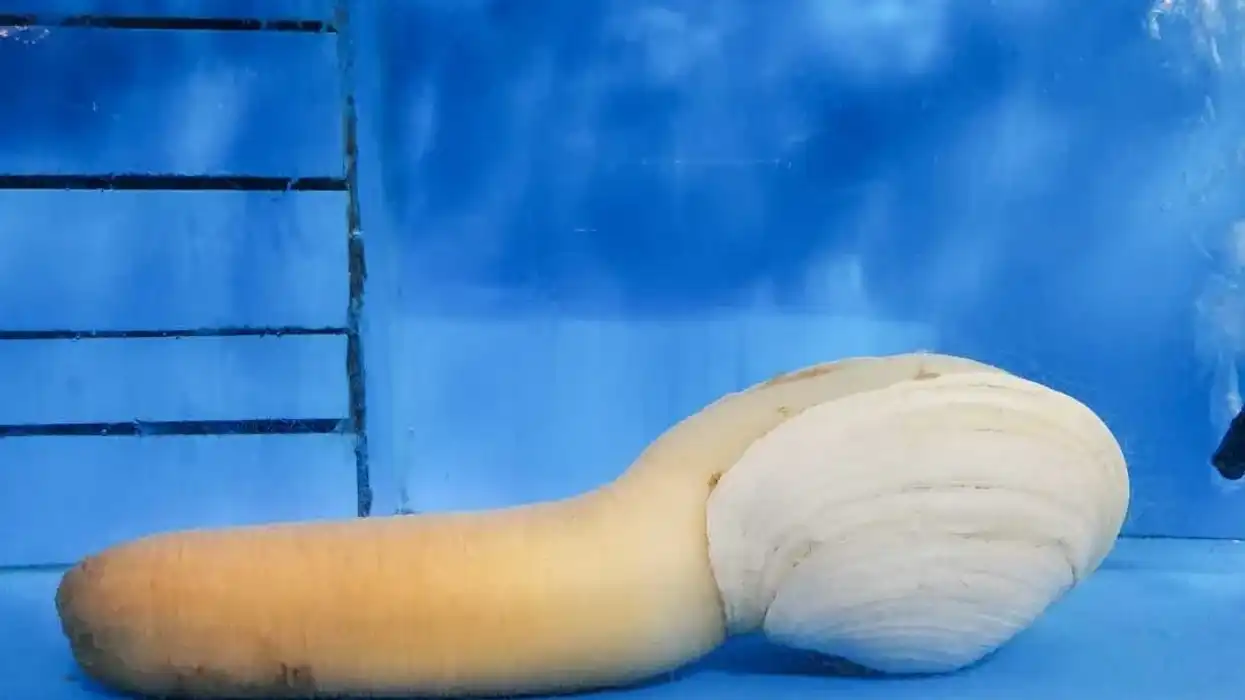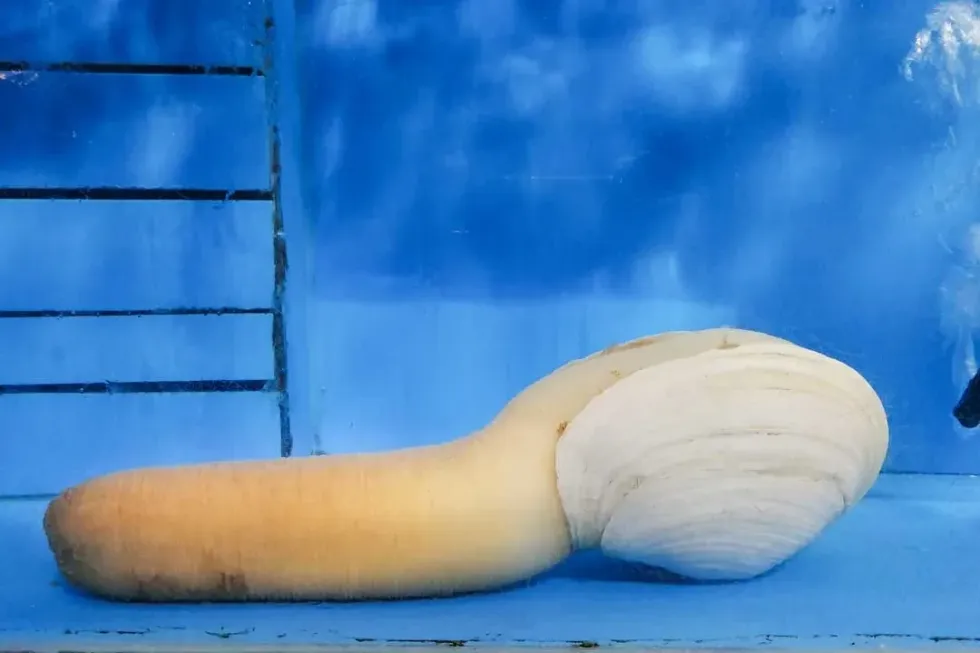Fun Geoduck Facts For Kids
Content
- What type of animal is a geoduck?
- What class of animal does a geoduck belong to?
- How many geoducks are there in the world?
- Where does a geoduck live?
- What is a geoduck's habitat?
- Who do geoducks live with?
- How long does a geoduck live?
- How do they reproduce?
- What is their conservation status?
- What do geoducks look like?
- How cute are they?
- How do they communicate?
- How big is a geoduck?
- How fast can a geoduck swim?
- How much does a geoduck weigh?
- What are the male and female names of the species?
- What would you call a baby geoduck?
- What do they eat?
- Are they dangerous?
- Would they make a good pet?
- Did you know...
- Why do geoducks have big noses?
- How to catch geoduck?
Geoducks, pronounced ‘gooey-duck’, are magnificent clams with an extraordinarily long siphon or neck which hangs out of a not-so-large shell. The geoduck shell measures up to a length of 7-9 in (17.8-22.9 cm).
The siphon, which is too long to retract into the shell, can grow up to 4 ft (121.9 cm). Geoducks can live in the wild for over 100 years.
The Pacific geoduck (Panopea generosa) is native to the coasts of the Pacific Northwest and western Canada. A geoduck is the largest burrowing clam ever to be found, probably the reason why it was originally named as ‘gweduc’ by the Nisqually tribe of Native America which means to ‘dig deep’.
Geoducks are called by other names in various places, such as mud duck, king clam, and elephant-trunk clam (in China).
Several species of geoducks are found in different parts of the world. The Atlantic geoduck (Panopea bitruncata) is found from the coast of North Carolina to the Gulf of Mexico.
Geoducks are an extremely savored seafood delicacy. They are known for their unique, crunchy texture and salty taste. They are commercially farmed and are a valuable export product selling for about $50-$150 a pound.
Geoducks can grow to be about 8 lb (3.6 kg). Mexico is known for farming the largest geoducks in the world. The second-largest species are found in the Pacific Northwest while smaller varieties are found in Argentina, New Zealand, and Japan.
In this article, you will find information like geoduck anatomy, geoduck dish, geoduck recipe, geoduck price, cooking geoduck, and so on.
For more relatable content, check out these elephant seal facts and leopard seal facts for kids.
Geoduck Interesting Facts
What type of animal is a geoduck?
A geoduck (pronounced gooey-duck) is a large, saltwater clam that is abundant on the northwest coast of the Pacific. It is a bivalved mollusk that has a shell and a long protruding nonretractile siphon.
It burrows deep into the ocean beds and can live for over hundred years. Geoducks make very sumptuous seafood and are very popular in the Pacific northwester, China and Japan.
What class of animal does a geoduck belong to?
Geoduck is a clam that belongs to the class Bivalvia of the phylum Mollusca. There are a number of geoduck species, the most common being Panopea generosa and Panopea bitruncata.
How many geoducks are there in the world?
There are several species of geoducks that grow and are harvested in the United States, Canada, New Zealand, and Argentina. However, geoducks grow in no other parts of the world.
Mexico harvests the largest geoducks. Panopea generosa, also known as the Pacific geoducks are the second largest wild geoducks to be harvested by the Pacific Northwest. Atlantic geoducks (Panopea bitruncata) are found in the coastal regions stretching from North Carolina to the Gulf of Mexico.
Where does a geoduck live?
Geoducks are saltwater clams, found deeply burrowed into soft, muddy, and sandy grounds along the coastlines. Geoducks are, in fact, the world’s largest burrowing clams. To find a geoduck, one has to dig deep. That is how it gets its name.
What is a geoduck's habitat?
Found in the Pacific Northwest and western Canadian coast, these marine clams are the world’s largest burrowing clams. From the lower intertidal zone, they live at a depth of about over 109.4 yd (100 m) and are buried deep on the ocean floor.
They burrow on soft, muddy, and sandy grounds. They are anchored there with a small ‘foot’ and live in the same place for the rest of their lives.
If you want to harvest a geoduck, you must be ready to go on all fours, in muddy, salty coasts and thrust your hands deep into the ground to get one out. You know you have spotted a geoduck if you see two of its siphon holes peeking out from the grounds.
There are other ways to spot it as well. Sometimes the neck may be hanging loose across the ground from a considerable distance.
Sometimes it is also just a big hole in the sand. That’s how geoduck farmers procure the clams from the coasts.
Puget Sound, an inlet of the Pacific Ocean in Washington state, is populated with the largest of these clams. Geoduck farming is popular in Puget Sound, which has harvested geoducks for over a thousand years now, or so it is said.
They are sold for over $100 a pound and make excellent seafood with an exquisite taste. Of late, farming and harvest are done under authoritative supervision for environmental purposes so as not to disrupt the marine ecosystem.
Who do geoducks live with?
Geoducks live in groups. Geoduck females release 7-10 million eggs. These eggs are fertilized in the waters followed by a larval period. Of course, not all the eggs survive. But those who survive burrow in the soft, muddy lands along coastlines. Hence, if you spot one geoduck, you are sure to find more in the surrounding areas.
How long does a geoduck live?
A geoduck can live for over 100 years. Though the average is about 140 years, there are specimens known to live up to 168 years. In fact, in Puget Sound, there was once found a geoduck which was 173 years old.
Geoducks grow rapidly in the initial 10-15 years, after which the growth diminishes. The shell weight continues to grow at a slow pace over the years due to an increase in the meat inside the shell, but the length of the shell subsides.
How do they reproduce?
Geoducks reproduce by the method of broadcast spawning where the females release eggs into the water to be fertilized by the male sperms. Females can produce over five million eggs during their lifetime.
Spawning occurs every year during May-July which is mainly attributed to the rise in temperature of the seawater. The eggs suspended in the water develop into larva.
These larvae settle at the bottom. When the shell size reaches about 0.1 in (2 mm), the larvae begin to burrow and grow in size. During the first two years, the baby geoducks are susceptible to threats from a number of predators like crabs, snails, shrimps, and fish.
As the shell of the geoduck grows and the siphon develops, they begin to burrow deep into the floor. They can reach up to a depth of 3 ft (91.4 cm), where they live for the rest of their lives.
What is their conservation status?
Geoducks are found abundantly in the north-western United States and in Canada. It is also found in Japan, China, and New Zealand where they are bred and harvested. They are large clams, weighing about 3 lb (1.4 kg) on average.
But some of the largest geoducks can weigh up to an incredible 8 lb (3.6 kg). Geoduck is a popular shellfish, easy to search in the markets of Washington state of US and also in the neighboring coastal areas.
Geoduck is a star item for export bagging a price of up to $150 per pound. Geoduck fishing is common on the west coast. It is also commercially harvested.
There are a number of shellfish farms that breed Geoducks. Geoducks are known to thrive in the Puget Sound region of Washington.
Along this coast, wild geoduck farming is a common sight. Holes are dug deep into the ground to extricate these shellfish from their burrows. Taylor Shellfish Farms is a shellfish farm in Puget Sound popular for harvesting geoducks.
Up until now, it has been given the status of a species of Least Concern. In Washington, the Department of Natural Resources regulates geoduck farming and harvest. The environmental impact of geoduck farming is closely monitored.
Over-farming can lead to an imbalance in the marine ecology. Geoduck farming has been going on for years in Puget Sound. This shellfish is a major export product and a multimillion-dollar industry.
Geoduck fishery involves using high-pressure water jets to dislodge a geoduck from its habitat. This can lead to the damage of the marine substrate. Increasing the use of these plastic gears and nets has raised concerns amongst environmentalists who think it can be damaging to marine life.
Geoduck Fun Facts
What do geoducks look like?

A geoduck is a bivalved mollusk having two rectangular-shaped shells and an elongated nonretractile siphon. The shell is typically 7-9 in (17.8-22.9 cm) long and has a dirty white or cream texture. The shell has distinct concentric growth lines on its surface.
The soft, muscly siphon is long and can grow up to a good 4 ft (121.9 cm). The siphon is somewhat reddish-brown. Geoducks burrow deep into the grounds and can live for over a hundred years buried in the same place.
How cute are they?
Geoducks are odd-looking creatures and cannot be called cute.
How do they communicate?
Though geoducks live in groups, they are not known to have a specific sound which they use for communication. They simply burrow in the grounds and live there for the rest of their lives. They reproduce by spawning.
How big is a geoduck?
A geoduck can be pretty big, as far as a shellfish goes. The largest geoduck is known to have a whopping weight of 8 lb (3.6 kg).
It has a shell size of 7-9 in (17.8-22.9 cm) and a siphon or neck which can grow up to 4 ft (121.9 cm). A colossal squid is 10 times bigger than a geoduck's siphon.
A geoduck is an interesting creature. It can even live for as long as 173 years. It is usually not very hard to search for a geoduck owing to its size, except that it remains buried deep in the ground and sometimes only peeps out through the siphon.
How fast can a geoduck swim?
They are sedentary for most parts of their lives.
How much does a geoduck weigh?
The average geoduck can weigh up to 3 lb (1.4 kg). But there are geoducks that can grow as large as 8 lb (3.6 kg), found mostly in the regions of Puget Sound, Washington. Blue catfish are 11 times bigger than geoducks. The giant clam weighs 500 lb (226.8 kg).
What are the male and female names of the species?
There are no separate names for male and female geoducks.
What would you call a baby geoduck?
After the eggs hatch, a geoduck goes through a larval stage. The baby geoduck is called by no specific name as such.
What do they eat?
The geoducks consume phytoplankton, fish larva, or any other food particle that they filter in through the siphon. The siphon brings in water loaded with phytoplankton and other food into the shell body. Food is filtered through and water is released back through another hole in the siphon. Geoducks require the cleanest of waters for their survival.
Are they dangerous?
No, a geoduck does not pose any threat to humans or other marine animals.
Would they make a good pet?
They do not make good pets.
Did you know...
Geoducks come with the flavors of the sea. They have a salty, crunchy flavor and taste as good as shellfish can be. They are extremely popular in the Chinese markets and are one of the most sought-after delicacies. Geoduck clams can even be had raw. The crunchy texture of the raw siphon gives this clam a unique taste.
Why do geoducks have big noses?
One thing to notice about a geoduck is its extraordinarily large siphons. Generally, the end of the siphon peeps out of the hole in which it burrows.
Geoducks take in water containing sea-water planktons down the siphon, filters it for food, and release the water back into the water bodies through another hole in the siphon. It uses the same hole for releasing eggs and sperms for broadcast breeding.
How to catch geoduck?
Geoducks are farmed in low tides. Geoduck digging and farming is a time-consuming process. There are certified areas for finding and farming geoducks.
Sometimes geoducks are easier to find when some part of their neck can be seen hanging loosely onto the ground. Sometimes it is just two siphon holes peeping out. At other times, they are stationed very deep and only a gaping hole in the soft gravely coast is the hint that gives them away.
During low tide, divers dive into the muddy water of the sea or the Pacific to search for geoducks in their habitat. Water hoses are extensively used in geoduck farming.
The farmers or harvesters spray a blast of water into the sandy bottoms to loosens the sand, making the geoducks lose their footing. The farmers then thrush their arms into the hole, sometimes all the way up to their shoulders to extricate these shellfishes from their homes.
Geoduck hunting is a recreational sport in Washington. There is even a geoduck song about it.
Geoduck farming and harvest, though still popular, are now overlooked by the authorities for environmental reasons. They ensure that the farming of shellfish does not disrupt marine life.
Here at Kidadl, we have carefully created lots of interesting family-friendly animal facts for everyone to discover! Learn more about some other mammals from our harp seal facts and fur seal facts pages.
You can even occupy yourself at home by coloring in one of our geoduck coloring pages.
We Want Your Photos!
More for You
Bachelor of Arts and Law specializing in Political Science and Intellectual Property Rights

Anusuya MukherjeeBachelor of Arts and Law specializing in Political Science and Intellectual Property Rights
With a wealth of international experience spanning Europe, Africa, North America, and the Middle East, Anusuya brings a unique perspective to her work as a Content Assistant and Content Updating Coordinator. She holds a law degree from India and has practiced law in India and Kuwait. Anusuya is a fan of rap music and enjoys a good cup of coffee in her free time. Currently, she is working on her novel, "Mr. Ivory Merchant".
Disclaimer
1) Kidadl is independent and to make our service free to you the reader we are supported by advertising. We hope you love our recommendations for products and services! What we suggest is selected independently by the Kidadl team. If you purchase using the Buy Now button we may earn a small commission. This does not influence our choices. Prices are correct and items are available at the time the article was published but we cannot guarantee that on the time of reading. Please note that Kidadl is a participant in the Amazon Services LLC Associates Program, an affiliate advertising program designed to provide a means for sites to earn advertising fees by advertising and linking to Amazon. We also link to other websites, but are not responsible for their content.
2) At Kidadl, we strive to recommend the very best activities and events. We will always aim to give you accurate information at the date of publication - however, information does change, so it’s important you do your own research, double-check and make the decision that is right for your family. We recognise that not all activities and ideas are appropriate for all children and families or in all circumstances. Our recommended activities are based on age but these are a guide. We recommend that these ideas are used as inspiration, that ideas are undertaken with appropriate adult supervision, and that each adult uses their own discretion and knowledge of their children to consider the safety and suitability. Kidadl cannot accept liability for the execution of these ideas, and parental supervision is advised at all times, as safety is paramount. Anyone using the information provided by Kidadl does so at their own risk and we can not accept liability if things go wrong.
3) Because we are an educational resource, we have quotes and facts about a range of historical and modern figures. We do not endorse the actions of or rhetoric of all the people included in these collections, but we think they are important for growing minds to learn about under the guidance of parents or guardians.







